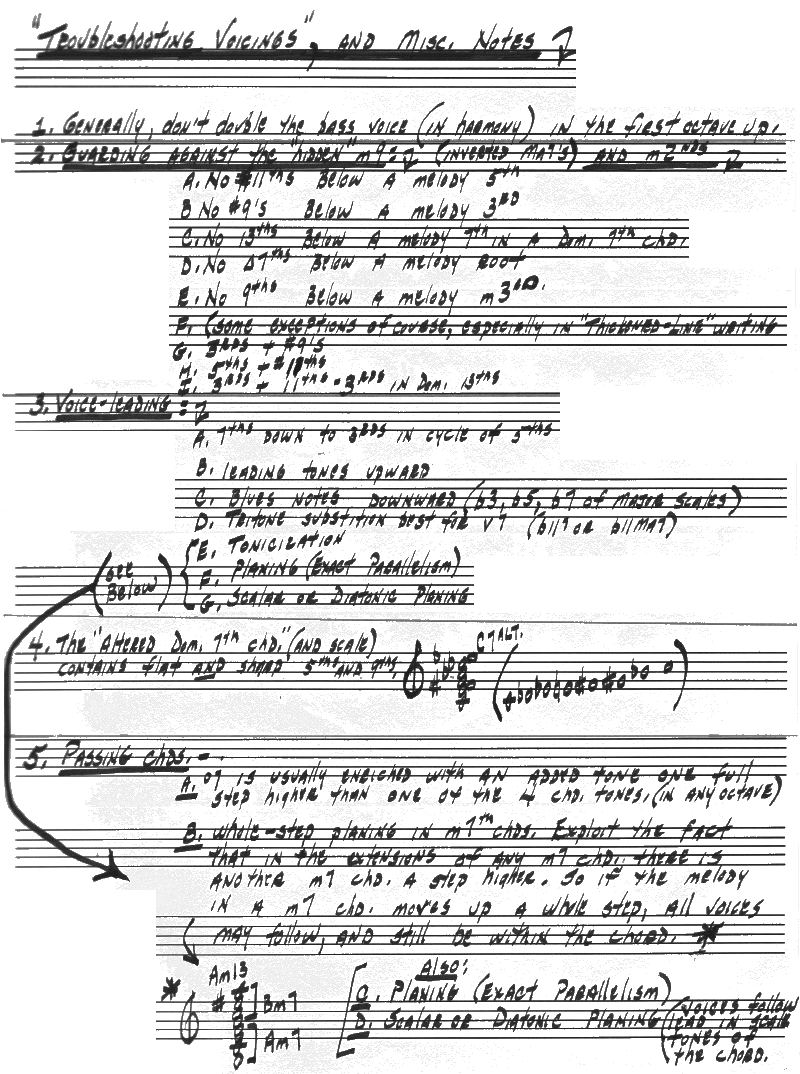Things To Avoid
I'll add to this list from time to time, as I think of other items.
Of course, the perception of music is subjective. So there may not be a "right" or "wrong" sound to your ears. The thoughts here are aimed at those who generally follow generally-accepted "rules" for voicing, voice-leading, etc..
This is a "trouble-shooting" section... Ways to find what is "wrong", when it seems that everyone is "playing the right notes". One example of such a a problem is in an arrangement where the chords are doubled in octaves... If you have two people playing a typical pop-style #9 chord in octaves, (root in bass, with the chord being 3 notes - 3rd, 7th, and #9th) you will have a "hidden minor 9th" (a minor 2nd) right in the middle. These things aren't always so obvious, and there are certain "rules" you can stick to, to avoid the problems.
Instrument selection in general:
Obviously, you can save yourself a lot of headaches is to become familiar with the ranges (and other "quirks") of all the instruments you're writing for. (See the range chart on the Music Theory page. Each instrument not only has a total range, but it has a "sweet" range, where most parts will sound the best. Remember the quote, "Because of the physical properties of instruments, the overtone series weakens as the fundamental generating tones ascend."
Unless you're writing for pros, be careful of writing at the extremes of any instrument's range. Otherwise, you may not be able to get the parts played. (!) The best approach with high trumpet parts, for example, is to write good-sounding parts for the rest of the trumpet section, and make the "extreme" parts optional for the "screech" player. That way, your arrangement doesn't fall apart because of a particular player's inability to play what you wrote. (Much more on this later, in the Arranging and Composing article, but here are a couple of examples:)
- When I was writing my first big band arrangements in high school, I would typically take them to the local college, or the local big band, to get them played first. These more experienced players could get through them faster than the high school band, and gave me a more accurate feel for what I had written. During the early stages of that process, I asked all the players what the "official" range of their instrument was, versus the "extended range", achieved by "false fingerings", etc.. Some of these older musicians had custom instruments... i.e., saxophones with extra keys to play lower notes, or trombone players with "triggers", etc.. If they didn't complain, I assumed all was well. But... Sometimes, I would then take the chart to someone who did NOT have these things, and they probably thought I was an idiot for writing something "impossible". (The better choice in these cases is to write TWO notes, making the more extreme one optional.)
- At one point, I wrote a rock-type arrangement for Findlay College, in Ohio, and one of the background parts was a fairly fast-moving part between B natural and B flat. I thought this would be natural for trombones, and wrote it that way. Later, I found that on a student-type tenor trombone, B flat is in first position, (slide all the way in) and B natural is in SEVENTH position. (slide all the way out) Now picture 4 trombone players wildly flailing away with their slides, trying to play that part, and the looks they were giving me. A little education is good. (!)
Unison playing:
There's a quirk you should remember when writing unison parts... "Write for one voice, or write for three or more voices." That's simply because a solo instrument can get away with "expressiveness", including pitch discrepancies, which would be annoying to the ear with two instruments. However, when you have three or more voices, things smooth out, to your ears.
Chord structures: (See the Music Theory page for examples.)
You should be produce the "flavor" of any chord with a bass note and 3 other notes. There's no need for other players to play the root of the chord, as a rule. The advantage of building chords like this, often built in intervals of 4ths and tritones, is that they're so versatile, requiring little movement to produce the IIm, IV, and V7 chords in the same key.
Idiomatic writing for brass and saxophones: (a few casual notes)

Be careful with octave doubling. You may run into "the hidden minor ninth" and other issues. (See below)
When things don't sound right, try this trouble-shooting guide:
